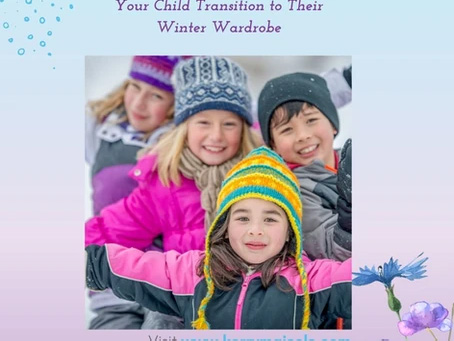Updated: Nov 24, 2023
School is back in session, the days are getting shorter, and there’s a crispness in the air. That can only mean one thing… It’s time to pull out those pants, coats, hats, and boots! For many, this seasonal change is met with excitement and anticipation of building snowmen and going skating. For some children, however, the switch to cold weather clothing can be a daunting challenge. The sensation of heavy coats, gloves, and scarves may seem constricting, and the unfamiliar textures of warmer fabrics can be uncomfortable. So, how can you help your child prepare for this yearly clothing transition with ease and confidence?
Start now. Don’t wait until that first really cold day to bring out the winter jacket and boots. Instead, make it a gradual process. Begin by placing winter clothing alongside your child’s current wardrobe. This simple act serves as a visual reminder of the upcoming change and provides an opportunity to discuss why these items are necessary. You can make it exciting by saying things like, “I can’t wait to put on my coat and boots so that I can jump in the snow!” Creating a positive association with winter attire can make a world of difference.
Include your child in wardrobe choices. Most parents will need to purchase at least 1 or 2 new pieces each season as their child grows. Bring your child to the store and get their input as to what they would like to wear. Maybe that bright red jacket you had in mind is too puffy for their liking. Allowing them to select clothing they feel comfortable in can prevent future battles over what to wear. Plus, it empowers them to make decisions and express their own style!
Offer choices daily. Allow your child to make choices about their clothing each day. You will need to set parameters (e.g., they must wear something that covers their hands and ears), but you can give your child the choice between mittens and gloves or a hat and earmuffs. This small decision-making process can instil a sense of independence and control.
Layer up. If your child is reluctant to part with the t-shirts and shorts, consider using layers. Thin, long-sleeved shirts and pants can be worn over top of their favourite clothing items. This way, they can maintain their preferred style while staying warm and cozy during the colder months.
Establish an “outdoor clothes” rule. As the parent or caregiver, you are responsible for keeping your child safe when they’re outside in cold weather. This means wearing warm clothing like a jacket, hat, etc. When your child is at home indoors, however, you can give them the chance to change back into something that is more comfortable for them. Set a clear rule like, “We wear a coat and boots outside. We can wear shorts inside.” For visual learners, you can place a picture representing “cold weather” clothing or “warm weather” clothing near their closet or dresser to help them differentiate between what type of clothing they will be expected to wear.
Model appropriate clothing choices. Children learn by example. If you want your child to wear a hat and gloves, be prepared to do the same. Show them that everyone in the family follows the same rules when it comes to staying warm in the cold weather.
By following these strategies and making the transition to cold weather clothing a gradual and positive experience, you can empower your child to face the chilly weather with comfort and confidence!
For more information about managing seasonal transitions, contact us at kmaisels@kerrymaisels.com.

